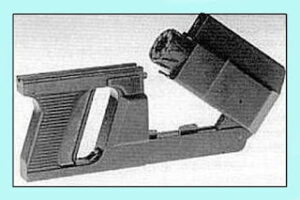Regular readers will know that I often find that diverse threads of research unexpectedly meet.
The other day I was contributing to a discussion on futuristic and unusual revolver designs. One such gun was the Vector 22 shooting system that was offered by an Albuquerque company called “Mark Three”. The Vector 22 had a number of novel features, one of these being a distinct lack of decent photographs of it on the internet! I may devote a future blog to this design once I find time to scan images from a few of my reference books.

The particular feature that interests me today is the grip and trigger. The Vector 22 had a grip somewhat like a saw. It was designed to be held with the first finger pointed down the side of the weapon and the lower three fingers around the grip. A rest for the tip of the forefinger can be seen top centre. Firing was by squeezing the grip so involved every finger except the trigger finger! The muzzle of the pistol was a little below the line of the first finger and close to the axis of the forearm.
Later, I am flicking through another book on a quite different subject and I come across the statement that when Jack Ruby shot Lee Harvey Oswald he pulled the trigger with his second finger and had his first finger pointed at the target. From the photographic evidence this does appear to be the case. Allegedly this was a technique taught to the SIS and SOE. Ruby may have arrived at the technique independently or may have learnt it from another source. He may have just grabbed the gun wrong in haste! Ruby had lost the tip of his forefinger but this was on his left hand. Pocket revolvers such as the Colt Cobra Ruby uses often have short grips. Working the trigger with the second finger may also be more comfortable with such a weapon. It would also place the bore-line lower down in the hand, helping to reduce felt recoil and muzzle climb. This technique is sometimes called “Point and Shoot” or “P&S.”


Sadly I do not have access to any firearms at the moment so I had to experiment with a pistol-shaped video game controller. I noticed that gripping with the second finger on the trigger did encourage a firm grip. This is an advantage when using the “Quick Kill” techniques advocated by Fairbairn and Applegate. Snap presentations tended to put the front blade over the target. Using the second finger seems to encourage “squeezing the grip” rather than “pulling the trigger”. This, and the lowered bore-line I suspect will tend to reduce movement of the firearm when firing. Overall the “weapon” seems more stable in this grip.
One the downside I noticed I had a tendency to apply pressure to the trigger with the second finger when I first gripped a gun in this fashion. Your initial experiments with this grip should be made with an unloaded weapon until you become more familiar with this technique. When using a loaded weapon be wary of the possibility of accidental discharges and keep your muzzle orientated in a safe direction at all times. You will also need to learn to keep the second finger off the trigger when not firing.
Ruby used this technique with a pocket revolver. It should work with an automatic providing that there is sufficient depth of the frame. Obviously you do not want your forefinger resting against the moving slide, over the ejector port or beyond the muzzle. It is not recommended for Colt M1911s. The pistol will also sit lower in the hand so there is the potential for “hammer bite” with some weapons. I suspect this is more likely to be a problem with some older designs rather than modern weapons. Finger guards can be constructed or purchased.

There is no reason why this technique should be restricted to pistols. Try it with a rifle or shotgun and see if it makes the weapon present better. A rapid fire technique for bolt-action rifles uses the second finger to work the trigger, freeing the first finger to manipulate the bolt.